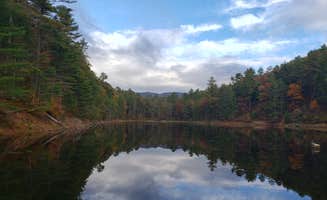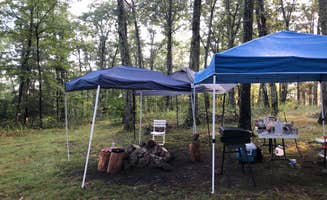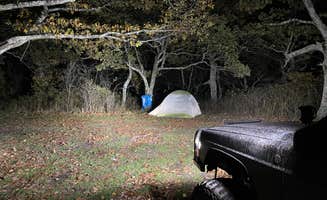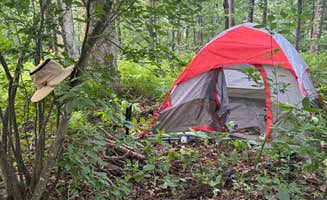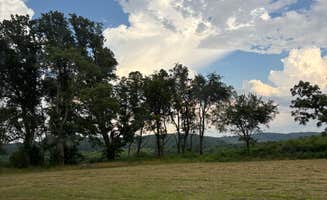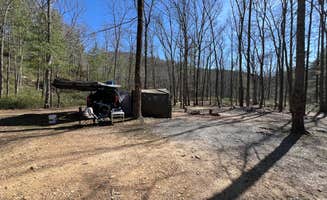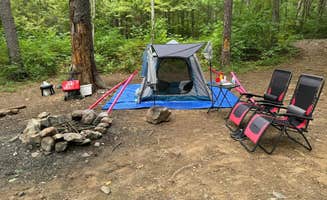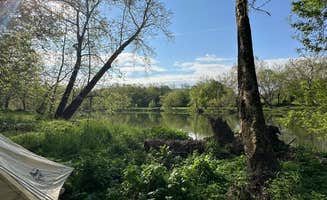Dispersed camping near Crimora, Virginia extends beyond the central area of George Washington National Forest, offering additional primitive sites within a 40-mile radius. Winter temperatures in this region often drop below freezing, with summer daytime highs reaching the mid-80s. The terrain varies significantly from flat creek-side camps to challenging high-elevation sites requiring specialized vehicles.
What to do
Hike the Appalachian Trail access points: At George Washington National Forest off 812, several hiking opportunities connect with the famous long-distance trail. "There's access to the App Trail on the road so you might see some hikers but it was real quiet otherwise," notes one camper. Another visitor adds, "There is a hike at the end of the road that takes you to a gorgeous summit and links to AT!"
Fishing opportunities: Multiple locations offer stocked fishing areas for catching trout. "The pond is stocked with trout in season, check DGIF site for dates," advises a visitor to Braley Pond. For those staying at Switzer Lake, "The fishing is decent, and we have caught some trout there in the past. There is a boat ramp at the lake, but only electric motors and paddle boats are allowed."
Off-road adventures: For campers with appropriate vehicles, the forest roads provide their own recreational opportunities. "The drive is pretty rocky, but nothing crazy. Take it slow and most vehicles can get by," notes one camper about Switzer Lake. Another mentions, "This is ideal for off-road adventures. Make sure your rig is equipped, this ain't for rookies!"
What campers like
Solitude and privacy: Many sites provide opportunities for complete seclusion. At Flagpole Knob, one visitor reports, "If you really wanna be alone this is the spot. Camped up there with just my dog and I doubt there was a single person for miles around." Similarly, at Switzer Lake, a camper notes, "I've camped here probably 12 times over the past 2 years and I seem to always find another awesome spot every time I go."
Water features: Creek and lake access add value to many primitive camping spots. "Nice camping spot in George Washington NF. The spot was nice and flat, backed up to a little creek and had an established stone fire ring," mentions one camper. Another visitor to Crisman Hollow Road Camp appreciates that "It's a quiet area with many spots right on the water."
Established fire rings: Despite the primitive nature of these sites, many feature preexisting fire rings. "There was a fire ring and man-made stone oven at the site we chose," notes a camper at George Washington National Forest off 812. Another visitor adds, "There are fire rings, firewood, and enough room to pull in, pitch a large tent, and hang hammocks."
What you should know
Vehicle requirements: Access varies significantly between sites. A camper at Spy Rock warns, "The hike up is brutal but the top is absolutely worth it." For Flagpole Knob, "This site requires a 4x4 vehicle with clearance. The trail leading to and from camp can be a bit tricky for some."
Limited or no amenities: Come prepared for fully self-sufficient camping. "There's nothing there so plan ahead for water and bathroom use," notes a visitor to Switzer Lake. Another camper adds, "Off the grid, no host, no plumbing, no electricity, no cell or data signal. No fees, no check-in."
Wildlife precautions: Bears and other wildlife are common in these areas. "About as flat as you'll get, the hike here was nice. It's a decently private spot with the trail close by, bugs weren't bad only gripe was bears were constantly checking out our tent during night," reports a camper at Laurel Prong Trail Dispersed. At Switzer Lake, a visitor warns, "There are bears here, so lock up your food in the car. We have encountered a bear at or around the campsite 3 times."
Tips for camping with families
Accessible primitive options: Some sites offer a gentler introduction to primitive camping. "I brought my boys out to camp this past weekend, and this place was perfect for our first dispersed campsite experience," notes a visitor about Braley Pond. "The day use area is close enough to use the bathroom (just an open pit toilet, nothing fancy)."
Creek exploration: Children often enjoy playing in the shallow waterways. "Though you can't swim in the lake, we did wade the stream, which was cold and clear and beautiful," shares one family at Braley Pond.
Trash management: Teaching children proper outdoor ethics is important. "We picked up and threw away the people's old trash btw. Leave it better than you found it and this awesome site will continue to be fantastic," advises a visitor to Braley Pond. Another camper at James River Wildlife Management Area mentions, "This isn't a campsite for the best 'scenery' or anything (though it is pretty in the morning), but it is quiet, secluded, and convenient."
Tips from RVers
Size-appropriate sites: Larger RVs have limited options in these primitive areas. "After turning onto Midway Mills Lane from the northern end (route 626), there is a gravel access road about .5 miles down the road that is well-maintained. It almost immediately opens up into an open field where large rigs of any size can fit," notes a visitor to James River WMA.
Cell service considerations: Connectivity varies widely throughout the region. "I had great T-Mobile service, but no ATT service—even with a powerful LTE antenna," reports a camper at James River WMA. Another visitor to Switzer Lake adds, "There is no cellphone signal for any carrier from what I could tell."
Road conditions: RV drivers must pay special attention to road quality. "The road was the worst and really not worth the drive in," warns one camper with a low clearance vehicle at Switzer Lake.


